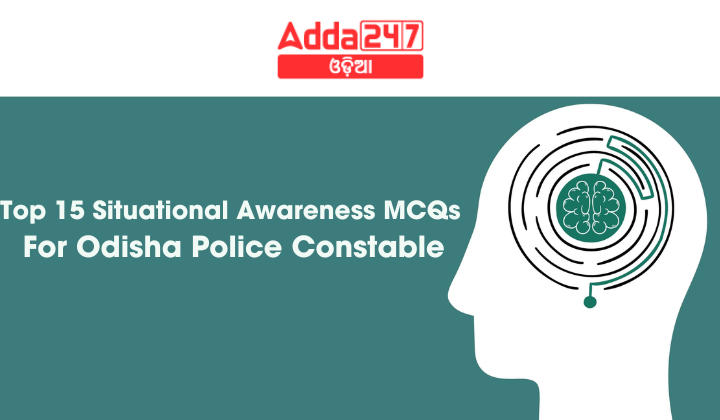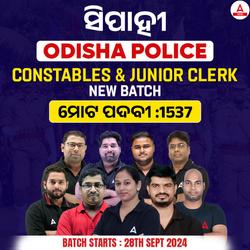Situational Awareness refers to the ability to understand, assess, and respond to situations appropriately, especially in stressful or high-stakes environments. For Odisha Police Constables, situational awareness is a key skill to handle emergencies, respond to crimes, and ensure public safety. Here are the top 30 multiple-choice questions (MCQs) that could help candidates prepare for the Odisha Police Constable exam, focusing on situational awareness and decision-making.
Top 15 Situational Awareness MCQs For Odisha Police Constable
Q1. While patrolling at night, you notice a vehicle parked in a no-parking zone. What should be your immediate action?
(a) Ignore the vehicle
(b) Issue a fine or warning
(c) Investigate the vehicle to check for any suspicious activity
(d) Wait for the owner to return
S1. Ans: (c) Investigate the vehicle to check for any suspicious activity
Sol: It is essential to assess the situation and ensure there is no security threat before issuing a fine or warning.
Q2. During a public event, a small group of individuals starts arguing loudly. What is your first course of action?
(a) Arrest all individuals involved
(b) Monitor the situation from a distance
(c) Intervene and attempt to calm the situation
(d) Call for backup immediately
S2. Ans: (c) Intervene and attempt to calm the situation
Sol: Calming the situation can prevent it from escalating, and this ensures public order is maintained.
Q3. While conducting a routine check, you notice someone behaving nervously near a restricted area. What should you do?
(a) Approach and question the individual
(b) Ignore the behavior
(c) Detain the individual immediately
(d) Call for backup before taking action
S3. Ans: (a) Approach and question the individual
Sol: Engaging the person in conversation allows you to assess whether the individual poses a threat or if their behavior is harmless.
Q4. While patrolling a crowded market, you hear a loud noise, possibly from a scuffle. What should you do first?
(a) Rush towards the noise
(b) Call for backup and then investigate
(c) Observe the crowd for any disturbances
(d) Secure a safe path for evacuation
S4. Ans: (b) Call for backup and then investigate
Sol: It’s important to ensure safety by calling for support before investigating the cause of the disturbance.
Q5. You are patrolling a residential area when a resident reports hearing suspicious noises from a neighboring house. What is your response?
(a) Ignore the report as it could be a false alarm
(b) Investigate the house discreetly
(c) Call for backup and investigate the noise
(d) Wait for confirmation from more residents
S5. Ans: (c) Call for backup and investigate the noise
Sol: Backup ensures your safety and proper investigation of a potentially dangerous situation.
Q6. A suspect flees from the scene of a crime. What should be your immediate reaction?
(a) Chase the suspect immediately
(b) Call for additional units and provide the suspect’s description
(c) Wait for the suspect to return
(d) Ignore the suspect and secure the crime scene
S6. Ans: (b) Call for additional units and provide the suspect’s description
Sol: Coordinating with other units can improve the chances of apprehending the suspect quickly and efficiently.
Q7. During a protest, the crowd begins to move towards restricted areas. What is your best course of action?
(a) Use force to stop them
(b) Alert the crowd and guide them away from restricted areas
(c) Call for immediate reinforcements
(d) Allow them to enter the restricted zone
S7. Ans: (b) Alert the crowd and guide them away from restricted areas
Sol: Guiding and managing the crowd peacefully ensures order and safety without escalating tensions.
Q8. While on traffic duty, you witness an accident involving multiple vehicles. What should be your first response?
(a) Help direct traffic away from the accident
(b) Provide first aid if necessary and call for medical assistance
(c) Wait for paramedics to arrive before acting
(d) Arrest the drivers immediately
S8. Ans: (b) Provide first aid if necessary and call for medical assistance
Sol: Ensuring the safety and health of those involved is the top priority in an accident situation.
Q9. You receive a report of a suspicious package left unattended at a bus station. What should you do?
(a) Immediately evacuate the area
(b) Investigate the package yourself
(c) Call the bomb disposal unit and cordon off the area
(d) Ignore it and continue your patrol
S9. Ans: (c) Call the bomb disposal unit and cordon off the area
Sol: Ensuring the safety of the public requires calling the appropriate authorities and securing the area to prevent harm.
Q10. While patrolling, you encounter a child who appears to be lost and crying. What should be your immediate response?
(a) Ask the child for details and try to locate their parents
(b) Leave the child and assume someone else will help
(c) Report the incident to your superior
(d) Take the child to the nearest police station
S10. Ans: (a) Ask the child for details and try to locate their parents
Sol: Engaging with the child helps resolve the situation quickly and ensures the child’s safety.
Q11. While on night duty, you spot a fire in a building. What is your first course of action?
(a) Try to extinguish the fire yourself
(b) Alert the fire department and evacuate people
(c) Wait for firefighters to arrive
(d) Direct traffic away from the fire
S11. Ans: (b) Alert the fire department and evacuate people
Sol: Prioritizing human safety and alerting professionals ensures the fire is handled effectively.
Q12. A colleague is handling a situation aggressively, causing tension. What is the appropriate way to handle the situation?
(a) Support your colleague no matter what
(b) Calmly ask your colleague to de-escalate and suggest a peaceful approach
(c) Leave the area and avoid conflict
(d) Criticize your colleague openly
S12. Ans: (b) Calmly ask your colleague to de-escalate and suggest a peaceful approach
Sol: De-escalating the situation professionally helps maintain order without worsening tensions.
Q13. You are at a traffic checkpoint and notice a driver acting suspiciously nervous. What should be your next step?
(a) Let the driver go as quickly as possible
(b) Question the driver about their destination and purpose of travel
(c) Detain the driver without questioning
(d) Ignore the behavior and continue with regular checks
S13. Ans: (b) Question the driver about their destination and purpose of travel
Sol: Asking questions allows you to gather information and assess whether further investigation is necessary.
Q14. During a patrol in a high-crime area, you notice a group of individuals loitering near a store after closing hours. What should you do?
(a) Confront the group immediately
(b) Observe from a distance and call for backup
(c) Arrest the group without any investigation
(d) Ignore the group
S14. Ans: (b) Observe from a distance and call for backup
Sol: Observing their behavior first ensures you act based on facts and reduce unnecessary escalation.
Q15. While on duty, you notice a suspicious item near a government building. What should you do first?
(a) Inspect the item closely
(b) Call for backup and alert the bomb squad
(c) Move the item to a safe location
(d) Ignore it
S15. Ans: (b) Call for backup and alert the bomb squad
Sol: Alerting the proper authorities ensures the situation is handled safely without risking lives.





